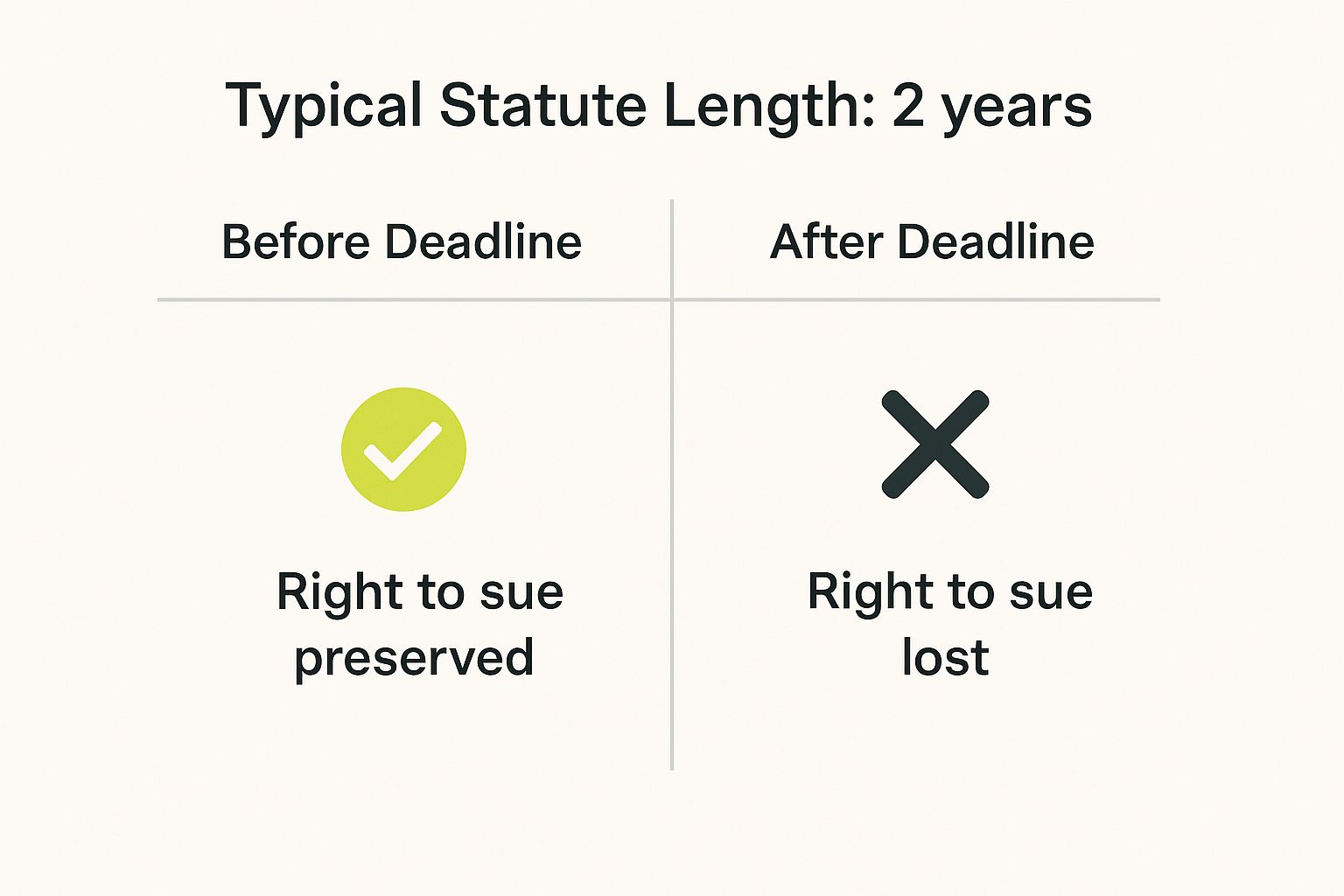Other Blogs
Check out other Legal AI Posts

Learn everything about the statute of limitations personal injury, including important deadlines and exceptions to protect your claim. Get informed today!

The statute of limitations for personal injury is one of the most unforgiving rules in the entire legal system. It’s a hard deadline that dictates exactly how long you have to file a lawsuit after an injury. If you miss that deadline, your client's right to seek compensation is gone forever—no matter how strong your case is.
Think of the statute of limitations as a countdown clock that starts ticking the moment an injury occurs. Once that clock hits zero, your legal options vanish.
The whole point of this rule is to keep the justice system moving efficiently. It forces claims to be brought forward while evidence is still fresh, witnesses can accurately recall what happened, and defendants aren't left with the threat of a lawsuit hanging over their heads indefinitely. A study published in the Journal of Legal Studies found that such deadlines encourage timely resolution and prevent stale claims from burdening the courts.
The consequences for missing the statute of limitations are brutal. You could have irrefutable evidence of another party’s negligence, but if you file your lawsuit even one day late, a judge will almost certainly throw it out. The merits of your case become completely irrelevant once that legal window closes.
Practical Example: Imagine you were injured in a slip and fall at a grocery store in a state with a two-year statute of limitations. You spend two years negotiating with their insurance company, who keeps assuring you a settlement is coming. If you don't file a lawsuit before the two-year anniversary of your fall, and the insurer suddenly stops talking, you lose your right to sue. Your case is over.
This infographic drives home just how black-and-white this concept really is.

There’s no gray area here. Filing on time protects your right to sue. Filing late means that right is permanently lost.
To get a quick handle on why this deadline is so important, take a look at this summary.
Simply put, this deadline isn’t just a procedural step—it's the first and most important hurdle you have to clear.
These deadlines aren’t just abstract legal theory; they affect millions of people every single year. The sheer volume of injuries that happen daily puts the importance of the statute of limitations for personal injury into perspective.
In the United States, medically consulted injuries from motor vehicle incidents alone totaled 5.2 million in 2022, according to the National Safety Council. On top of that, the U.S. Bureau of Labor Statistics reported 2.8 million nonfatal workplace injuries and illnesses in the private sector for 2022, highlighting just how many people’s rights are governed by these time limits.
These are staggering numbers. With thousands of injuries occurring every day, these legal clocks are constantly ticking down, deciding who gets their day in court and who doesn’t. You can dig deeper into the scope of personal injury statistics and their legal implications to see the bigger picture. This initial deadline truly sets the stage for everything that follows in a personal injury claim.

There’s a common misconception that a single, nationwide statute of limitations for personal injury exists in the United States. It doesn't. Instead, every state sets its own rules, creating a complex patchwork of deadlines that can make or break a case.
The clock that matters is the one in the state where the injury happened, not where your client lives. Crossing a state line can mean the difference between having years to file a claim and having the door slam shut in a matter of months.
The timelines vary wildly. Some states give you a very short window, demanding you act fast (meaning you need to get that demand letter drafted sooner rather than later). Others offer a much longer runway to prepare a lawsuit.
Imagine two car accidents on the same day. One is in Tennessee, where the statute of limitations is a tight one year (Tenn. Code § 28-3-104). The other is just a few hours away in Missouri, where the victim has a full five years to file (Mo. Rev. Stat. § 516.120).
It's the same type of injury, but the legal deadlines are worlds apart, all based on geography. This is why knowing the specific jurisdiction is so important. Luckily legal ai tools such as ProPlaintiff.ai amplify law firm productivity, accelerating case timelines and ensuring no potential compensation for your clients slip through the cracks.
So why the huge variation? It all comes down to a balancing act by state legislatures. They have to weigh an injured person's right to seek justice against a defendant's right to not have an old claim hanging over their head forever.
States with shorter deadlines often prioritize fresher evidence and faster resolutions. On the other hand, states with longer deadlines tend to value giving victims more time to fully grasp the extent of their injuries, which can take months or even years to surface.
The sweet spot for most states is somewhere in the middle. A two-to-three-year window is the most common timeframe for personal injury claims. For example, New Jersey gives you two years, while New York provides three. You can explore how these timelines impact personal injury claims internationally to see how this concept plays out globally.
This legal tug-of-war creates the diverse map of deadlines that every personal injury attorney must master.
To bring this from theory to practice, let’s look at a few concrete examples. The table below really drives home just how much the general filing deadline can change from one state to the next.
A quick look at this table makes the stakes crystal clear. A client injured in Maine has three times longer to file a lawsuit than someone hurt in Florida or Texas.
Missing a detail this crucial isn't just a mistake; it's malpractice. It’s the difference between a successful recovery and a case that’s over before it even starts, reinforcing why you must consult an attorney licensed in the state where the injury took place.

Knowing your state’s filing deadline is only half the battle. The other, more critical piece of the puzzle is pinpointing the exact moment that legal countdown begins. It’s not always as simple as the day of the accident.
The start date for the statute of limitations for personal injury hinges on one of two key legal principles. Understanding which one applies to your client's case is everything.
The most common starting point is the "date of injury" rule. This one is pretty straightforward. For most personal injury cases, like a car wreck or a slip and fall, the clock starts running on the very day the incident happens. The injury is immediate and obvious, so there's no confusion about when the timer began.
But life—and the law—are rarely that simple. What happens when an injury doesn't show up for months, or even years? This is where the legal system offers a much-needed layer of fairness.
Many injuries don’t announce themselves right away. Think about it: a surgeon might leave a medical instrument inside a patient, a factory worker could be exposed to asbestos, or a faulty medical device could slowly degrade over time. In these scenarios, the victim has no idea they've been harmed.
This is exactly where the "discovery rule" comes into play.
The rule states that the statute of limitations clock doesn't start until the date you discover the injury, or the date you reasonably should have discovered it with due diligence. It's a fairness doctrine, plain and simple. It’s designed to protect people who couldn't have possibly known they were harmed on the day the negligence occurred.
A rock-solid medical history is your best friend when arguing the discovery rule. Building a clear timeline of symptoms and doctor visits is often the key to the entire case. To get a better handle on this, check out our guide on how to build a personal injury medical chronology.
Let's look at how these two rules play out in the real world. The contrast shows exactly why the discovery rule is so vital for certain claims.
This distinction is fundamental. Without the discovery rule, countless victims of medical malpractice or latent occupational diseases would lose their right to sue before they even knew they had a case.
A report from the U.S. Department of Justice shows that less than 10% of tort cases filed in state courts go to trial. This stat really underscores why the statute of limitations is so critical. Since most cases settle, these deadlines create the window where all negotiations have to happen, making the start date—especially one determined by the discovery rule—incredibly important in complex cases.
While the statute of limitations for personal injury feels like a hard-and-fast rule, it’s not always set in stone. The legal system gets that some situations make it unfair—or flat-out impossible—for an injured person to file a lawsuit on time. In these specific cases, the law allows the deadline clock to be paused.
This pause is a legal concept known as tolling. Tolling essentially freezes the countdown until whatever was preventing the lawsuit is resolved. It's a critical lifeline for people who, through no fault of their own, can't pursue their legal rights within the standard window. These exceptions are specific and require solid proof, but they are vital for making sure justice is truly accessible.
This is probably the most common exception everyone recognizes. Children can't legally file a lawsuit by themselves. To protect their right to seek justice, the law pauses the statute of limitations until they’re old enough to take legal action.
In most states, the clock for a child's personal injury claim is tolled until they turn 18. Once they become a legal adult, the standard statute of limitations for their claim finally starts ticking.
Practical Example: Imagine a 10-year-old is hurt by a defective toy in a state with a two-year statute of limitations. The clock doesn't start on their 10th birthday. Instead, it’s paused for eight years. On their 18th birthday, the two-year countdown begins, giving them until their 20th birthday to file suit. This makes sure they get a fair shot at pursuing their claim as an adult.
Much like the rule for minors, the law makes an exception for adults who are mentally incapacitated and can't manage their own affairs. This might happen because of a severe brain injury from the accident itself, a pre-existing cognitive condition, or being in a coma.
If a court has formally declared someone legally incapacitated, the statute of limitations can be tolled.
This exception is all about fairness. A person shouldn't lose their legal rights when they are mentally incapable of understanding or acting on them. The clock typically stays paused until the person’s mental capacity is restored or a legal guardian is appointed to act for them. For instance, if someone is in a coma for a year following a crash, that year may not count against their filing deadline.
Justice can’t be served if the person being sued—the defendant—is never notified of the lawsuit. So, what happens if the defendant skips town or goes into hiding to avoid being served with legal papers? The legal system has an answer for that.
Most jurisdictions will toll the statute of limitations for any period that the defendant is out of the state or actively hiding. This stops a wrongdoer from just running out the clock to dodge accountability.
Practical Example: A driver causes a hit-and-run in Florida, which has a two-year statute of limitations. Right after the crash, the driver moves to another country for one year to avoid a lawsuit. Under Florida's tolling rules, that one-year absence wouldn't count. The injured person would effectively have three years from the accident date to file, since the clock was paused while the defendant was gone. You can see how Florida Statutes § 95.051 addresses these kinds of specific exceptions.
Not all personal injuries are created equal in the eyes of the law, and neither are their filing deadlines. While a general statute of limitations for personal injury might cover a standard car accident, the rules can shift dramatically for more specialized claims.
The type of injury and who you're suing can trigger entirely different—and often much shorter—timelines.
Failing to spot these nuances is one of the biggest traps in personal injury law. Assuming a two-year deadline applies to everything is a recipe for malpractice. Claims involving medical errors or government negligence come with their own unique rulebooks, and you have to follow them perfectly to keep your client's case alive.
Medical malpractice cases are notoriously complex, and their statutes of limitations reflect that. On the surface, the deadline might look similar to a general injury claim, but it's almost always tied to the "discovery rule" we talked about earlier. This makes sense, as the damage from a medical mistake might not show up for months or even years.
Take Florida, for example. The statute of limitations for medical malpractice is generally two years. But that clock doesn't start ticking until the patient knew—or reasonably should have known—that the injury happened and that there was a decent chance it was caused by malpractice. This creates a flexible but tricky start date that demands meticulous proof.
Crucially, many states also have a statute of repose, which is an absolute, final deadline. In Florida, a med mal claim generally cannot be filed more than four years after the incident, no matter when it was discovered, with only a few very narrow exceptions. This means if a surgical error from five years ago is just discovered, it may be too late to sue.
When a defective product (like a faulty airbag or contaminated food) causes an injury, the case falls under product liability law. These claims often have a different statute of limitations than a simple negligence case.
In many states, the deadline is actually longer. While Florida has a two-year limit for general negligence, it gives you four years for a product liability action. This extra time allows victims to connect their injury to a specific design or manufacturing flaw.
But just like malpractice, these claims are also governed by a statute of repose. This final deadline prevents a manufacturer from being on the hook for a product forever. It sets a hard stop, often 10 to 12 years after the product was first sold, after which no lawsuit can be filed, even if an injury just happened.
The countdown for a wrongful death claim starts at a completely different point. Instead of beginning on the date of the accident, the statute of limitations for a wrongful death lawsuit begins on the date of the person's death.
This distinction is absolutely vital. Someone could be hurt in a car crash and linger in a coma for a year before passing away. In a state with a two-year deadline, the family would have two years from the date of death—not the date of the crash—to file their claim.
Suing a government entity is the most procedurally demanding type of personal injury claim. Forget the statute of limitations for a moment; before you can even file a lawsuit, you must first comply with strict "notice of claim" requirements.
These are incredibly short deadlines to formally tell a government agency you intend to sue.
Only after you’ve cleared these preliminary hurdles does the official statute of limitations clock start. If you miss that initial notice deadline, your claim is almost certainly dead on arrival. It’s the most urgent timeline to manage in any personal injury practice. For instance, a slip and fall on a cracked public sidewalk has a much faster and more complex process than a similar fall inside a grocery store.

Knowing the rules of the statute of limitations for personal injury is one thing, but protecting your rights requires taking immediate, decisive action. The steps you take in the first few hours and days after an injury can make or break your ability to recover compensation down the road.
Think of it as building your case from day one. The clock is already ticking, so being proactive is your best defense against a missed deadline—and a lost claim. Your focus should be on locking down evidence and protecting your legal position before crucial details start to fade.
While every case is different, a core set of actions will always safeguard your interests. Follow this checklist to make sure you're building the strongest possible foundation for your personal injury claim.
These initial steps are all about creating a clear, undeniable record of what happened and how it impacted you.
Sooner or later, you'll get a call from the at-fault party's insurance adjuster. They might sound friendly and helpful, but their one and only job is to minimize their company's payout. It is critical to avoid giving a recorded statement or accepting a quick settlement offer before you've spoken with an attorney.
Adjusters are trained to ask leading questions that can be used against you later. An innocent apology or even saying you "feel okay" can be twisted to suggest you were at fault or that your injuries aren't serious. For example, if you say, "I'm sorry this happened," they may try to interpret that as an admission of fault for the accident.
Let a legal professional handle these conversations. An experienced lawyer knows the tactics insurers use and will protect you from saying something that could torpedo your case. They’ll make sure all communications, including any formal settlement talks, are handled correctly. If you're getting ready for those negotiations, our guide on crafting effective demand letters offers tips to get the best outcomes.
Ultimately, the single most important step is contacting an experienced personal injury lawyer as soon as you can. They will take on the burden of managing deadlines, dealing with insurance companies, and building your case, which lets you focus completely on your recovery.
When you're dealing with a personal injury claim, the legal jargon can feel overwhelming. This section is here to clear up a few of the most common questions we hear about the statute of limitations in personal injury cases, giving you straightforward answers to understand where you stand.
Let’s be blunt: if you miss the filing deadline, your case is almost certainly over.
The court will have no choice but to dismiss your lawsuit, and your right to get any financial compensation from the at-fault party disappears forever. It doesn't matter how strong your case is or how clear the evidence is—this deadline is one of the most rigid rules in the entire legal system.
Yes, and this is a critical detail that trips up a lot of people. The identity of the defendant can drastically change your timeline.
For instance, a standard car accident claim against another driver might give you a two-year window to file suit. But if you were injured by a city bus, you're now suing a government entity. This changes everything. You'll often have to file a formal “notice of claim” in as little as six months, long before the actual statute of limitations even kicks in. If you miss that initial notice deadline, your lawsuit is likely barred before it even starts.
One of the most dangerous myths out there is that negotiating with an insurance company pauses the legal clock. It absolutely does not. You must file a formal lawsuit in court before the deadline runs out to protect your rights, no matter how close you think you are to a settlement.
No, the discovery rule is an exception, not the standard. It isn't a get-out-of-jail-free card for every situation.
It’s most often used in very specific types of cases, like medical malpractice or claims involving latent injuries from toxic exposure—situations where the harm isn't immediately obvious. In a straightforward personal injury case, like a slip and fall, the clock starts ticking the day of the incident because the injury is apparent from the get-go.
To use the discovery rule, a court has to be convinced that you truly could not have reasonably discovered your injury any earlier. For more complex situations that require specific legal filings, knowing how to file a motion can be a game-changer.
At ProPlaintiff.ai, we build the AI-powered tools that give personal injury firms an edge in managing complex documentation and critical deadlines. Our AI Paralegal helps your team build precise medical chronologies, summarize dense case files, and generate compelling demand letters, freeing them up to focus on strategy and winning. See how we can help your firm by visiting https://www.proplaintiff.ai.
Check out other Legal AI Posts
